AMD's A10-5750M Review, Part 1: The APU and Radeon HD 8650G Performance
by Dustin Sklavos on June 28, 2013 12:00 PM ESTSystem and Futuremark Performance
While AMD's Enduro software is apparently still a mess on Intel-based systems, I actually found my only problem with it was messing with the interface to disable the MSI GX60's Radeon HD 7970M. For the purposes of isolating the A10-5750M's performance and giving it the best chance I could, I swapped in a second memory stick from the much maligned MSI GT70 Dragon Edition I recently reviewed and then disabled the 7970M.
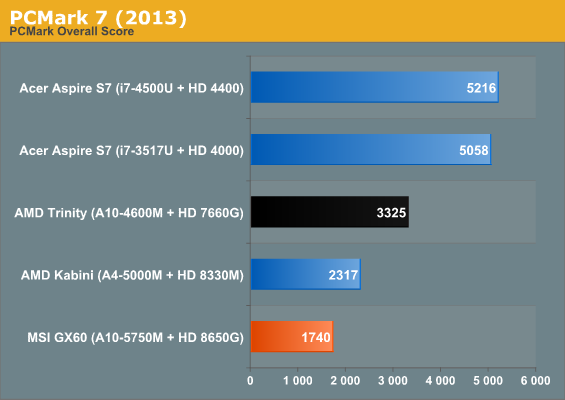
PCMark 7 is always going to respond primarily to the storage system, so the GX60's SSD takes a bath. What we want to see are scores that more directly isolate the performance properties of the A10-5750M itself.
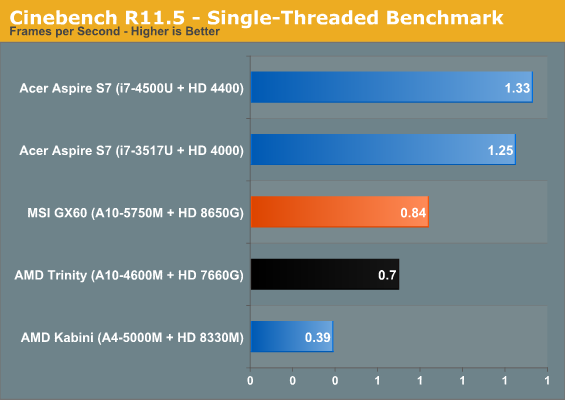
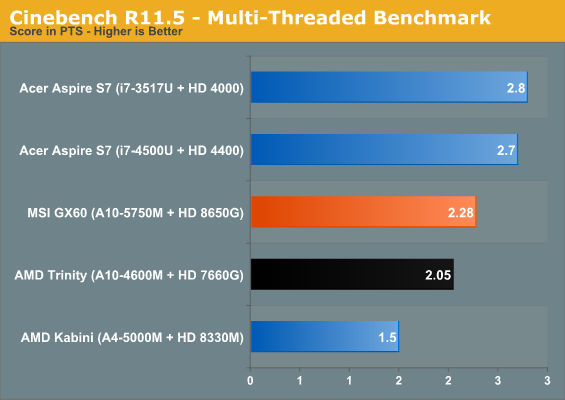
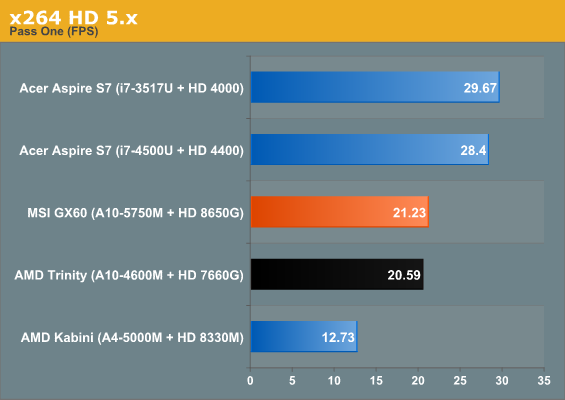
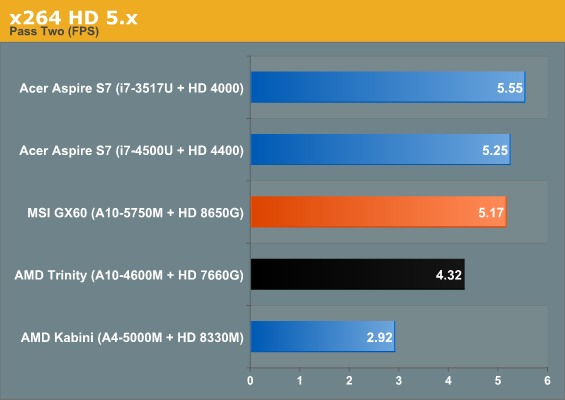
On the CPU side, we can see that Richland provides a healthy performance boost over Trinity. Only the first pass in our x264 benchmark doesn't show a notable jump, but the second pass boasts a remarkable 20% increase in performance. We're still some way from catching up to Haswell, much less Ivy Bridge, but I'll take the improvement where I can get it.
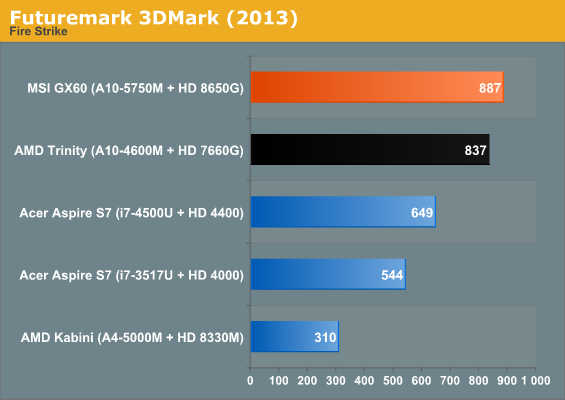
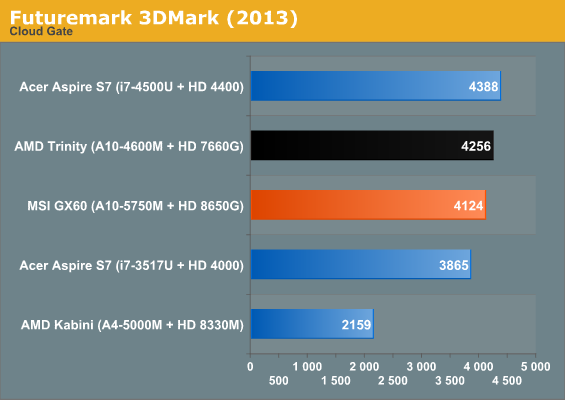
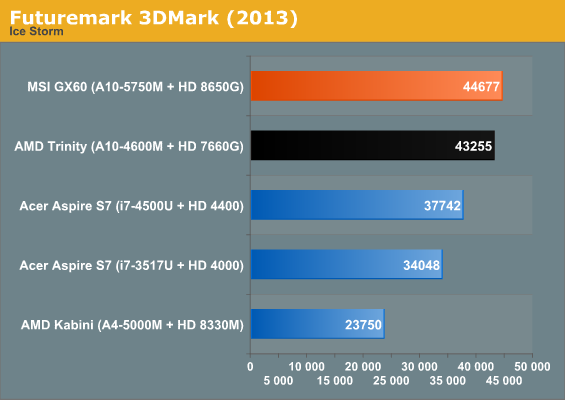
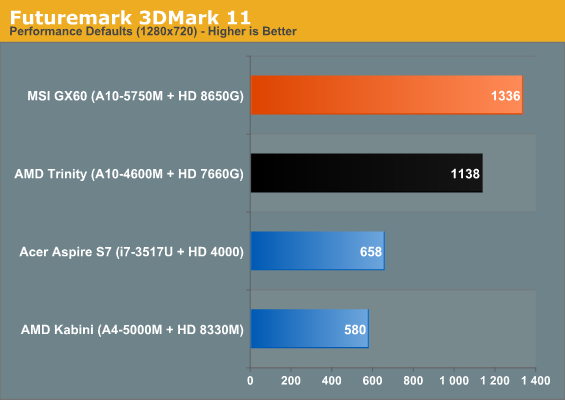
3DMark also continues to heavily favor AMD's on-die graphics, but while CPU performance got a healthy boost from Richland, the refresh doesn't move the needle on the graphics hardware nearly as much. It's generally improved apart from the odd results in the Cloud Gate test, but Richland's primary reason for being seems to be driving up CPU performance.










82 Comments
View All Comments
kyuu - Saturday, June 29, 2013 - link
I'm referring specifically to the GT3e parts, of course, in case it wasn't clear.trisct - Friday, June 28, 2013 - link
AMD won't interest me again until there's a high end APU with GCN cores available. I wouldn't buy a CPU that is about to be surpassed by a game console.Rontalk - Friday, June 28, 2013 - link
"Unlike with Trinity, AMD didn't seed Richland reference notebooks to reviewers"Ha ha, I wonder why!
Shivansps - Friday, June 28, 2013 - link
Why is compared to a ULT Haswell? it shouldt be compared to mainstream mobile Haswell parts?FwFred - Friday, June 28, 2013 - link
To be fair, there are only i5 and i7 mobile Haswells released. The i5s only come in the 15W (GT2/GT3) and 28W (GT3) variety. The GT3 comparison would be very interesting, but I'm not sure Anand has any of these parts.Beenthere - Friday, June 28, 2013 - link
Richland appeals to those who want the best performance/value relationship in a laptop. Few people know or care if a laptop APU is properly rated at 35w or falselty advertised as 17w like Intel does. What most laptop buyers care about is running actual software and reasonable battery life. Richland delivers what the majority of consumers desire and at a price that won't break the bank. When you compare performance based on retail price, Richland is the winner not the $200+ more expensive Intel models.junky77 - Friday, June 28, 2013 - link
thanks for the reviewwhat about power consumption?
Khato - Friday, June 28, 2013 - link
In the many years that I've been reading Anandtech this may well be the first article of genuinely disappointing quality. It's clearly a conscious decision on the part of the author to omit the Haswell GT3 and GT3e benchmarks of previous reviews, apparently justified by the opinion expressed on the third page of, "The only reprieve AMD seems to be getting on this front is the unusual rarity of GT3-enabled parts in the market." And since the Haswell SKUs with faster graphics were omitted from the benchmark results leaving only the low-end 15W GT2 SKU to fight for the title against AMD's top of the line 35W Richland we get the bizarre conclusion of, "AMD continues to offer superior mobile graphics." What's even worse is that the author then acknowledges the fact that AMD has markedly slower graphics in their A8 and A6 lines. (The commentary on desktop Haswell in a mobile review is also a tad bit grating.)Anyway, I've always liked Anandtech as articles typically include all the relevant information along with informed commentary. Hopefully this review is merely a random anomaly.
Vi0cT - Friday, June 28, 2013 - link
I agree with you in the sense that Dustin can/should get higher quality stuff out but are you taking into account the price difference for GT3/GT3e enabled solutions?.The last time I checked, an Iris Pro 5200 enabled SKU was around ~600 USD with the price difference you can get a current gen discrete mobile GPU(from AMD or NVIDIA) then Intel doesn't stand a chance (GPU).
As far as results goes in the HD 4000 <> HD 5000 comparison article the only benchmark we can relate to is Futuremark 3DMark 11.
Resuming for you here:
MSI GX60 (A10 5750M + HD8650G): 1336
AMD Trinity (A10 4600M + 7660G): 1138
Intel HD 5000 ( 2013 13-inch MBA): 1080
So... HD5000 good lower results than Trinity, and considering that the HD5100 just got +0.1Ghz I don't think it's close to Richland.
Then there is Iris Pro 5200, and then we get into HD 8850M /GT 750M territory price-wise.
Not to mention that right now the AMD APU is a better option in the price/performance department (for gaming).
esgreat - Friday, June 28, 2013 - link
I the MacBook Air was power constrained (15W part). Iris 5100 is a better comparison not because of it's +0.1GHz nominal frequency change, but it's ability to operate at higher power (28W). This means it doesn't have to throttle down on power as frequently.